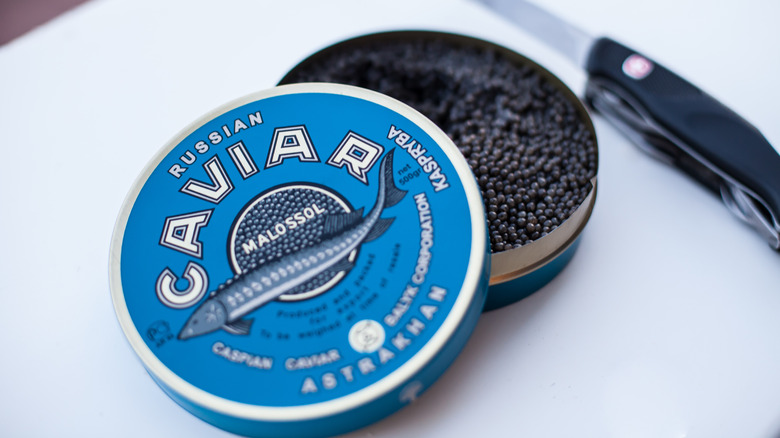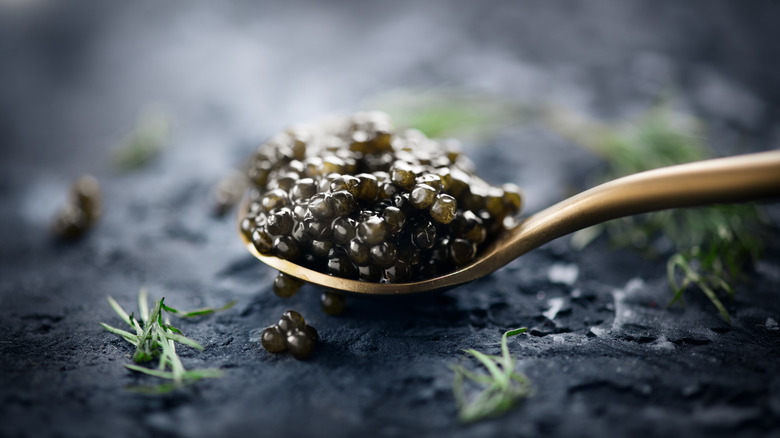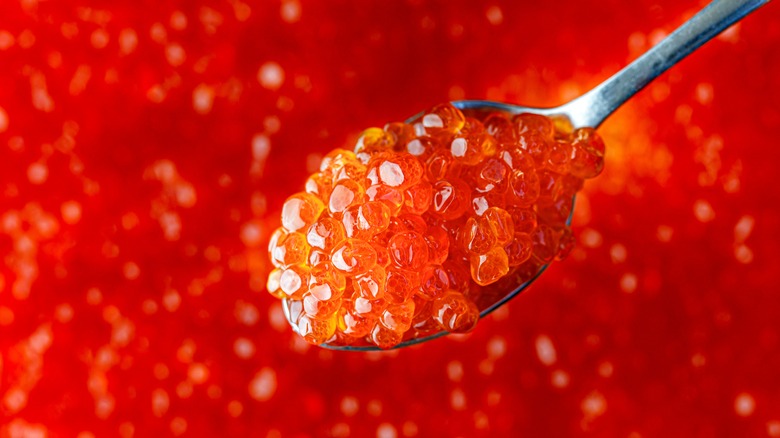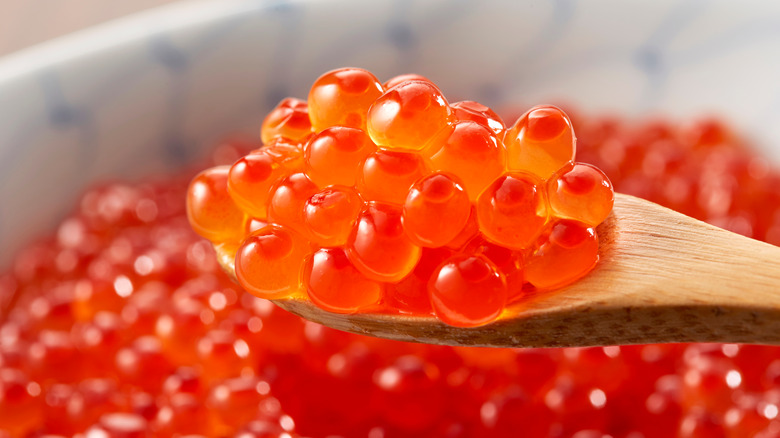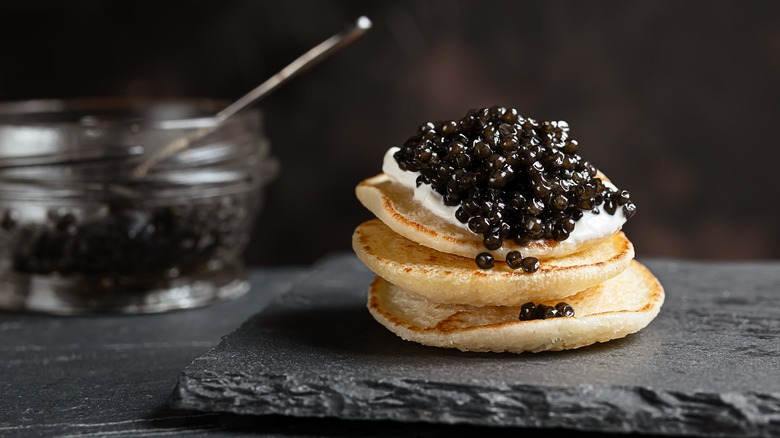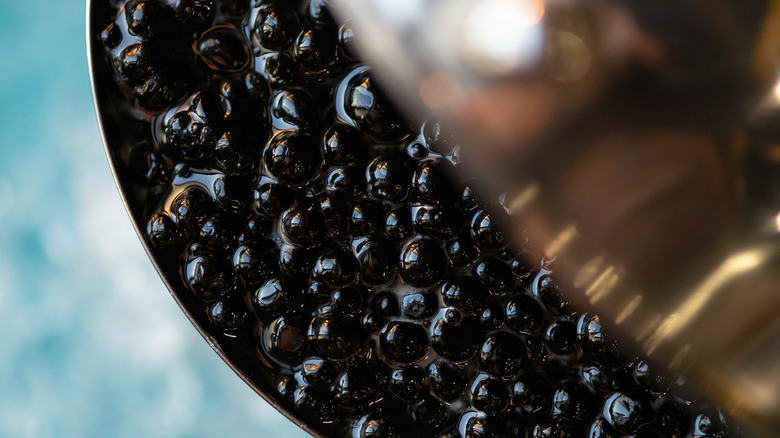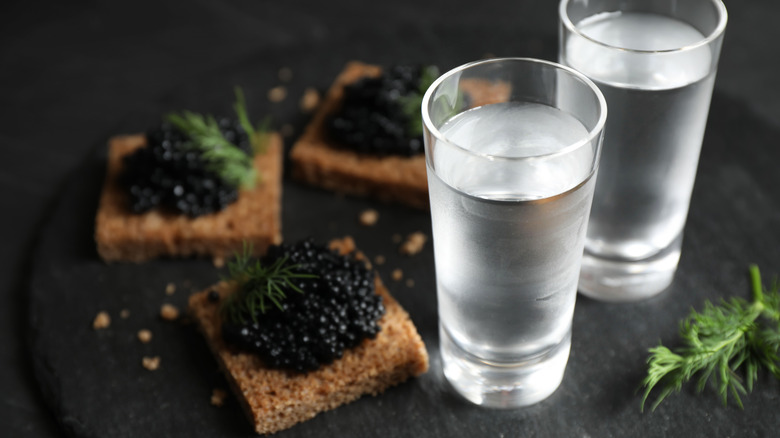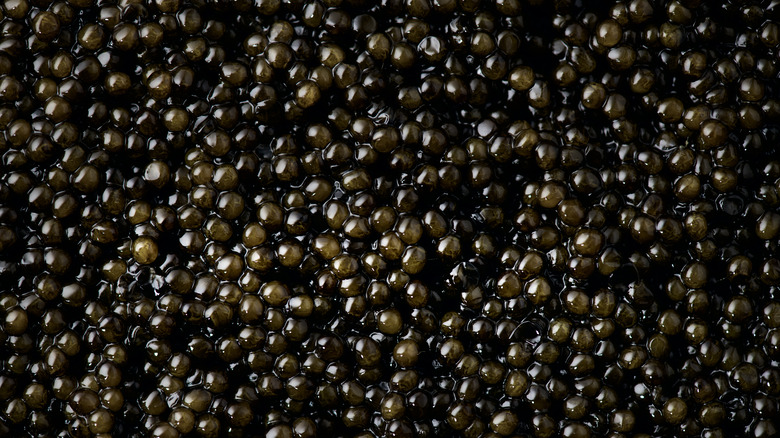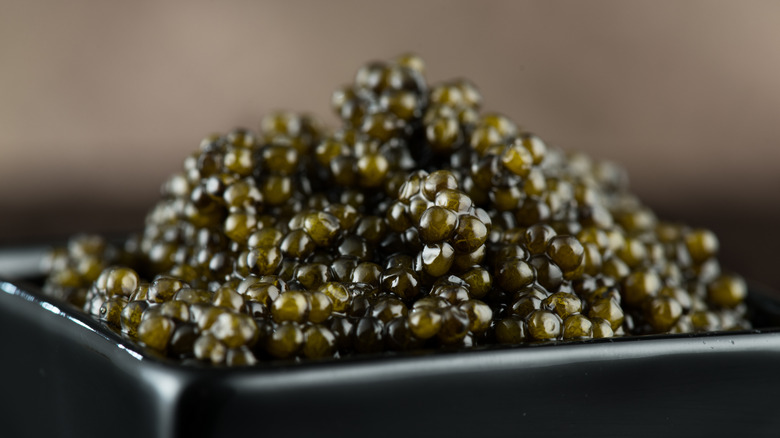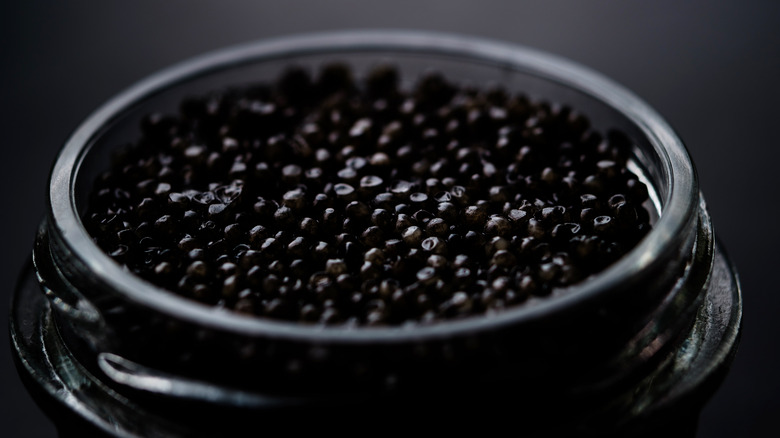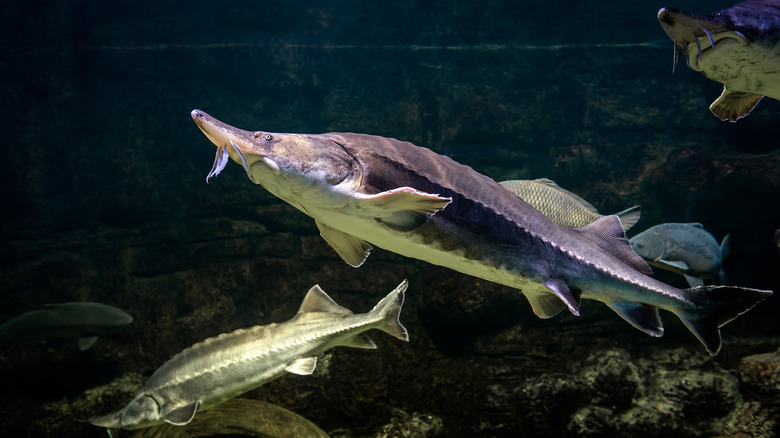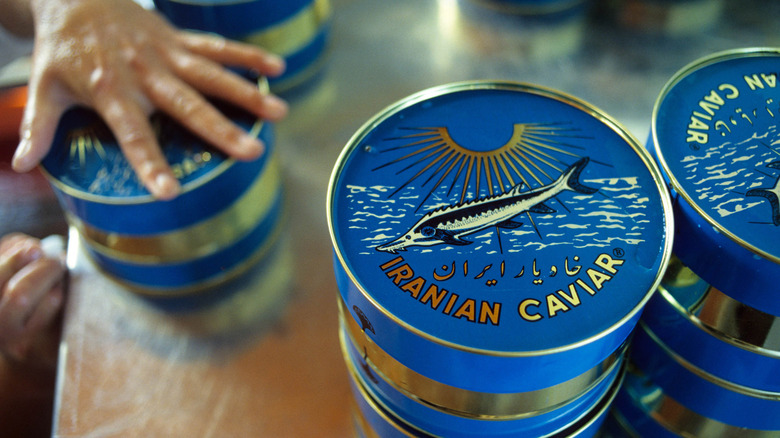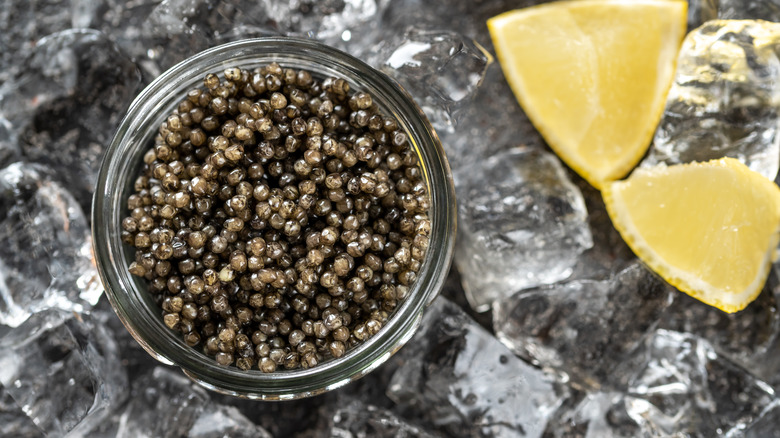The Untold Truth Of Caviar
There is perhaps no food more closely associated with luxury than caviar. The eggs of the sturgeon fish are some of the most expensive food products in the world, and it's widely regarded as a delicacy. You're most likely to find caviar in a specialty store or on the menu of a fine dining restaurant, which means that the treat is inaccessible to some. However, not everyone even wants to try it: To some, the idea of downing fish eggs is a less-than-appealing prospect.
Because caviar is so expensive and exclusive, it can seem hidden under a shroud of secrecy. You're probably not going to find it at your local grocery store, so many have never even come across it and know surprisingly little about it. However, as it turns out, there's a lot to learn about caviar. The delicacy has a storied past, a troubled present, and an unclear future. One thing is for sure, though: It doesn't look like the wealthy are going to stop downing their fish eggs anytime soon.
If you're interested in learning more about this iconic ingredient, you're in the right place. This is the untold truth of caviar.
Caviar costs close to $3,500 per pound
If you know one thing about caviar, it's probably that it's expensive. Although it's not quite as pricey as it has been in the past, that's still true. There are various types of caviar available on the market, and not all of them are of the same quality. However, the most expensive variety comes from the beluga sturgeon. The eggs from a beluga sturgeon are larger than eggs from other types of sturgeon, and they're also rarer than other varieties due to the complexity of raising and harvesting the fish. This puts a high price tag on beluga caviar. According to MasterClass, you're looking at about $3,500 a pound.
It's not uncommon to see caviar sold in tins containing about two ounces of fish eggs. That means you're looking at over $200 for a relatively small serving. And keep in mind that caviar is more of an accoutrement than a main dish: Even if you eat the whole container, you're still definitely going to be hungry afterward. As you can see, at this price point, caviar is firmly in the territory of luxury food.
Of course, you can find lower-quality caviar available for a less expensive price, but you should still expect to pay good money for caviar no matter where you buy it.
Fish roe is not technically the same thing as caviar
Those who frequent sushi restaurants may have tried roe or tobiko, which are also fish eggs. Wondering why your roll didn't cost hundreds of dollars with all of those eggs? That's because roe and caviar technically aren't the same thing. Well, at least, caviar is roe, but not all roe is caviar, according to MasterClass. Roe is a general term used to describe the eggs of marine animals, including fish and other creatures like sea urchins. Those large, round, red jewel-like eggs that burst in your mouth? That's salmon roe. And the tiny red fish eggs they cover your sushi with are known as tobiko, which is also sometimes referred to as flying fish roe.
Caviar, on the other hand, is the roe from a very specific type of fish called a sturgeon. Technically, only sturgeon roe can accurately be called caviar. While caviar is rarer, more expensive, and more difficult to source, that doesn't mean that roe isn't delicious — in fact, you may even find that you actually like it more. Generally, other types of roe are much, much less expensive than caviar, so if you want to want to experience the pleasure of eating fish eggs without the hefty price tag, go ahead and score yourself a roe ... and keep your bank account in check.
There are plenty of cheaper substitutes for caviar
People who love the taste of caviar but just can't justify spending hundreds of dollars on a barely-there snack may be looking for caviar alternatives, and luckily, there are quite a few to choose from. Of course, we're already mentioned that you can pick up salmon roe or tobiko if you're looking for something less expensive. These treats are often available at Asian or fish markets, especially in major cities, so be sure to check there first.
However, there are other alternatives to choose from, per MasterClass. If you want fish eggs that are enjoyed in much the same way as is caviar, try trout eggs. Their golden color and large size make them visually appealing in addition to their delicate flavor. But what about the vegetarians and vegans out there? No worries — there's a caviar substitute for you too. It's called seaweed caviar, and it's exactly what it sounds like: seaweed formed into tiny fish-egg-shaped morsels and combined with plenty of salt. Does this stuff taste exactly like real caviar? No. But if you're going for that slightly nutty, ocean flavor, they can definitely do the trick. Not only is seaweed caviar significantly less expensive than the real thing, it's also a more sustainable choice.
It's often served on blinis as an appetizer...
If you've had caviar before, there's a good chance it was served on a blini, which is a typical caviar pairing, according to The Spruce Eats. A blini is basically a small Russian pancake that's used as a carrier for other ingredients. Since blinis have a rather unremarkable taste, they're great carriers for the intense flavors of caviar. Oftentimes, the blini and caviar are complemented by crème fraîche, a kind of thick cream that's reminiscent of cheese (albeit much milder).
Of course, it's not always possible to find blinis, so if you want to recreate the taste but don't want to make your own, it's easy to find substitutes. Some people love eating their caviar with crackers, while others prefer toast points. Basically, any neutral-tasting bread-like carb will likely work well here. Regardless of what caviar is served on, it's almost always raw and chilled — you're not likely to encounter cooked caviar.
...But it can be added to tons of other foods or eaten on its own
While eating your caviar with a blini may be one of the more traditional ways in which the delicacy is served, that doesn't mean you have to stick to the basics. In fact, caviar can accompany a wide variety of dishes and add a fun pop of flavor and texture to even the most seemingly un-fancy foods. Forbes points out one of the most popular modern-day pairings: caviar and fried chicken. It might sound strange, but trust us — the fried breading and the salty fish eggs are a match made in heaven.
You can also put caviar on sandwiches like lobster rolls and burgers, but generally, these sandwiches are kept pretty simple so as not to lose the flavor of the caviar in all of those competing condiments. Potato chips also make a great addition to any caviar spread, as their salty but nondescript flavor and crunchy texture complement caviar exceptionally well.
Moral of the story? If a dish sounds like it would be good with caviar on top, there's a good chance it will be. If you happen to get your hands on some fish eggs, don't be afraid to experiment and try something different.
Caviar and vodka are a classic Russian pairing
Caviar may hail from Iran, but Russia is largely responsible for popularizing it: It has been a staple in Russia for centuries. But you may not know that vodka, another Russian staple, has been regarded as the perfect pairing for high-quality caviar, according to The Moscow Times. According to writer Lana Matafonov, vodka is "known to help bring out the flavor of the caviar," so they are often served together — with blinis, of course — and an egg.
Generally, when caviar and vodka are paired together, the vodka is served plain (or over ice) and cold. When chilled, its flavor is quite light, which allows the taste of the caviar to take center stage. Some think of this pairing as a classic similar to wine and cheese: the flavors complement each other perfectly, and one is incomplete without the other.
Of course, you shouldn't feel beholden to tradition if you don't particularly like vodka or you just want to enjoy your caviar with an alternate beverage. However, a pairing as iconic as this one is almost always worth a try.
Caviar tastes buttery and salty
Those who haven't tasted caviar before may be wondering what the hype is all about anyway. How can fish eggs be that good ... and that expensive? It's true that caviar isn't for everyone, and if you don't already like seafood, then it may not be what you're looking for. But for those who love very textured food, it's hard not to love caviar ... and the flavor is fantastic too, especially if you're getting the good stuff. The Spruce Eats describes the flavor of caviar as "buttery," and that's spot on. Other flavors will vary depending on what kind of caviar you select.
Osetra, for example, has a nuttiness to it that many caviar enthusiasts go wild for. If you're looking for something different, sevruga might be more up your alley — it has a strong, intense flavor (though not aggressively fishy), and the eggs pop in your mouth when you let them roll into your tongue. The Spruce Eats describes kaluga as "delicate," which makes it a good option for those who are just getting started on their caviar journeys.
Despite their differences, most caviar falls under the same flavor umbrella. You're looking for that lovely buttery flavor with a hint of seawater. If you already like seafood, there's a good chance you'll enjoy caviar.
Caviar could be used to treat depression
Depression is a common mental health problem that many people struggle with. Of course, if you're battling depression, you should see a medical professional to get the help you need. However, there is some evidence that caviar could potentially be used to treat depression, per WebMD. Technically, it's not caviar specifically that could help with depression. Rather, it's omega-3 fatty acids, which are found in a variety of different seafood. Studies have shown that depression is less of a problem in parts of the world in which fish — like the fish that caviar comes from — is eaten regularly. Early research indicates that sufferers of bipolar disorder can also benefit from plenty of fish, like caviar, in their diets.
This doesn't exactly mean that you should go out and buy several tins of caviar just to cure your depression. Speaking to a medical professional is your best bet, and the research in this area is still young. But hey, if eating something delicious helps make you feel a tiny bit better, it can't hurt to add it to your plate on occasion.
It used to be used to treat impotence
Depression is one thing, but apparently, that's not where the magic of caviar ends. In medieval Persia (modern-day Iran), caviar was used for the treatment of impotence, per the journal Nature. There were many foods thought to assist male reproductive function, and caviar was one of them, amongst other foods like skink, shark, moray eel, and dairy products. And when you consider the fact that caviar is, in fact, just fish eggs, it makes sense — it's part of one animal's reproductive system, so it's logical to think that it could be good for the human reproductive system as well.
The idea of caviar as an aphrodisiac hasn't gone anywhere, though: Some still tout its supposed romance-enhancing abilities. The Mayo Clinic says that there's not much evidence to support the idea that aphrodisiacs are actually effective, but we're going to guess that your date won't be opposed to opening up a tin of the good stuff to give it a try.
Sturgeon, the fish that caviar comes from, is endangered
One of the reasons caviar is prized as a delicacy comes down to the fact that it's incredibly tricky to harvest, and it takes a ton of resources to do so. Much of the caviar we eat today is farmed, largely because sturgeon are endangered, according to the World Wildlife Fund. Though this species has been around since the time of the dinosaurs, it is now facing extinction in the face of overfishing and the loss of its natural habitats. While caviar from sturgeon found in the Black and Caspian Seas used to be common, international trade of these foods from the region are now banned.
However, caviar producers are now turning to alternate methods of getting fish eggs on your plate. Many sturgeons are now farmed in the hopes of creating a more sustainable source for caviar, according to The Guardian. But some have decided to turn away from caviar for good due to its lack of sustainability. Of course, that's a decision you have to make for yourself, but if you do want to eat caviar and be as responsible with your consumption as possible, it's always a good idea to verify that your caviar is farmed.
Caviar is one of Iran's main exports
Caviar is generally thought of as a Russian good, but Iran is a major exporter of the food, according to The Culture Trip. That's because Iran borders the Caspian Sea. It's even believed that people in the Persian Empire were the first people to ever taste caviar and were also the first to add flavor to it by salting it. These days, caviar is one of Iran's main exports. In fact, it brings more money into the country than crude oil.
Even though much of the world's caviar may call Iran home, that doesn't mean that it's a popular delicacy in the country itself. In fact, you'll rarely find caviar in the country's cuisine. The Culture Trip says that finding it in a restaurant there is a rare occurrence. Of course, it is possible for Iranians to buy it in the country, but the majority of the caviar from Iran eventually makes its way to other parts of the world, mainly Europe.
Caviar was once regarded as peasant food
These days, caviar is almost synonymous with wealth. However, it turns out that caviar didn't always have such lofty associations. According to The Moscow Times, all the way back in the 12th century, caviar was regarded as a food fit for peasants. It was served, strangely enough, by the bowlful — hard to imagine in these times. People often paired it with porridge for a cheap form of sustenance. But before long, caviar would seal its fate as a legendary food fit for the ultra-wealthy. When the tsar Ivan the Terrible started eating caviar — and loving it — its status as a food rose exponentially. Ever since that time, it's solidified its place in history as a veritable delicacy.
While it may be difficult to imagine caviar being regarded as a food for peasants now, it's not the only seafood to meet this kind of fate. According to Business Insider, lobster was similarly seen as a lowly food in times past. It just goes to show that many of the delicacies we enjoy today are actually quite arbitrary.
